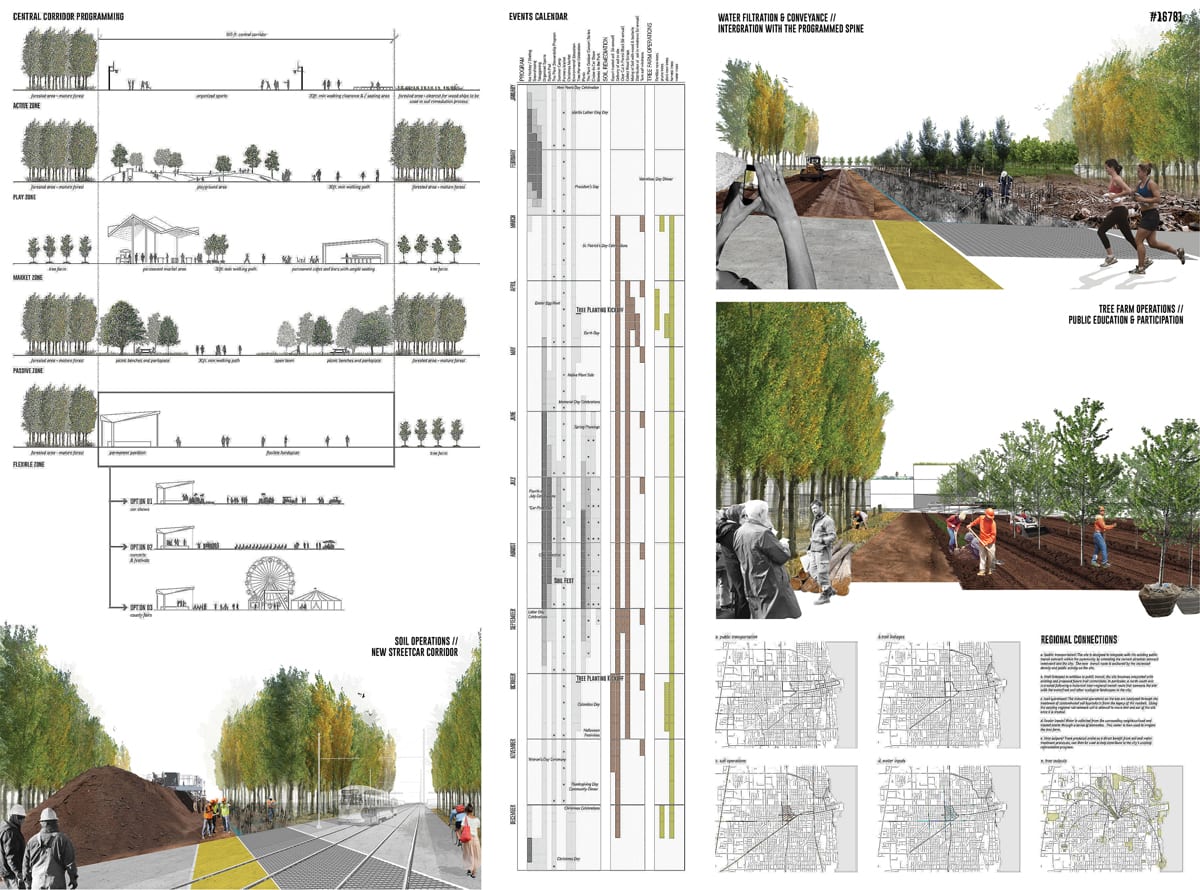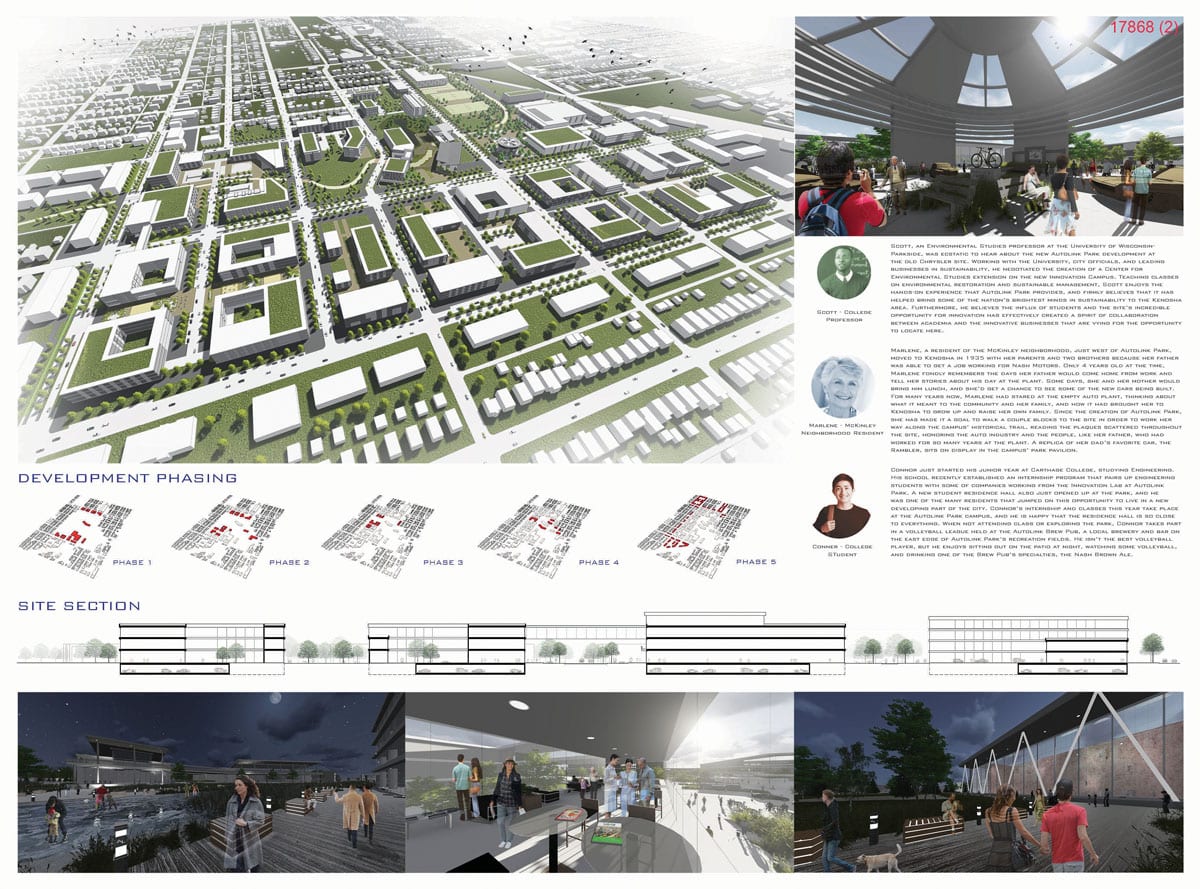by Stanley Collyer

As a mid-sized rustbelt city in the Midwest, Kenosha, Wisconsin was especially hard hit by auto plant closings. First it was the American Motors plant in 1988. Then, to compound matters, the Chrysler Engine plant closed in 2010. Such closings not only resulted in the loss of high-paying jobs, but left a desolate void in the urban fabric. Some of these vacant spaces have recently become the object of design competitions, staged with the intention of generating ideas to reinvigorate abandoned areas. One of these was the Redesigning Detroit competition, focused on the previous site of Hudson’s Department Store in the city’s central business district (2013 COMPETITIONS Annual). ÂÂ ÂÂ
More recently, UD4U, a Chicago-based non-profit, staged a planning competition for the abandoned Chrysler engine plant in Kenosha, Wisconsin. The site, located in the city less than a mile from Lake Michigan and would seem to be an ideal location for housing and other similar projects. This was a large, open site—107 acres—surrounded mostly by detached residential housing. The location of eight schools within one-half mile attests to the residential density of the area surrounding the site. Since the plant closing, the structures have been demolished, and only the concrete slab surface remained from what at once was a productive industrial plant.

The competition was international and “open to professionals and students of all countries, with the requirement that they either be in, or previously graduated from, a professional/registered university with a degree in one of the following: architecture, urban design, urban planning, landscape architecture, or engineering. Participants of the competition were asked to create their vision of what the site should become. The program was completely open, so the use and function of the structures, open spaces, etc. was completely up to each team. However, every team was asked to address 4 aspects that are vital to the site being a success and beneficial for the community.” Those 4 aspects were: • history of the site and city • the site’s surrounding urban fabric • industries of Kenosha • transportation options. The problem with many of these abandoned manufacturing sites is their environmental history. They normally would require a massive cleanup, and, as “hot sites,” may never be regarded as a location for a viable project. In Kenosha, $10M has been set aside for a cleanup of the site, and, at this writing, the remediation process has already begun. As has occurred with other similar sites in Kenosha, it is assumed that local, state, and federal government entitities will contribute additional funds as needed until the cleanup process is complete. All that aside, the very nature of the size and location of the site made it ideal subject matter for an ideas competition. And, although this was just an ideas competition, it provided a number of workable ideas for the site and could give the city fathers some food for thought. The jury was made up of three outside experts and three members of UD4U:
• Andrew Moddrell, Director of PORT
• Christine Carlyle, Urban Planner
• Andrew Vesselinovitch, City Traffic Planner
• Elizabeth Fallon, UD4U, Architect
• Matthew Clapper, Planner, UD4U Principal and Founder
• Kaleb Quirin, UD4U Project Manager
The competition attracted 43 entries from the U.S. as well as foreign countries. Seventeen countries were represented among the submissions, with roughly half originating from the U.S. As might be expected, the challenge drew a plethora of ideas, from public gardens, sports facilities, mixed living and working complexes to even an auto racing track. After final consideration, the jury settled on the final winners:


 “Ring of Events” presentation boards (click to enlarge)ÂÂÂÂÂÂÂÂÂÂÂÂÂÂÂÂÂÂÂÂÂÂÂÂ Jury Comments: “Ring of Events was unique and interesting because you can belive that it could be a campus of some kind, either a corporate headquarters or an innovation center, as proposed. Additionally, it acheived this without being overbearing and was selective with its amount and scale of structures. Therefore, allowing a large portion of the site to be open space that could be enjoyed by the surrounding community.”
“Ring of Events” presentation boards (click to enlarge)ÂÂÂÂÂÂÂÂÂÂÂÂÂÂÂÂÂÂÂÂÂÂÂÂ Jury Comments: “Ring of Events was unique and interesting because you can belive that it could be a campus of some kind, either a corporate headquarters or an innovation center, as proposed. Additionally, it acheived this without being overbearing and was selective with its amount and scale of structures. Therefore, allowing a large portion of the site to be open space that could be enjoyed by the surrounding community.”
Jury Comments: “This project isn’t really a long term solution for the site, but rather the next 5-10 years or so during the remediation process. Even though this project wouldn’t be permanent, it is an incredibly interesting and sustainable way to deal with the site as it is “in flux.” It creates a whole new industry and series of events that would generate a bit of revenue, as well as a sense of community, all while helping remediate the soil and actually contribute to the cleanup process, rather than impede it.”
Los Angeles, CA
















































